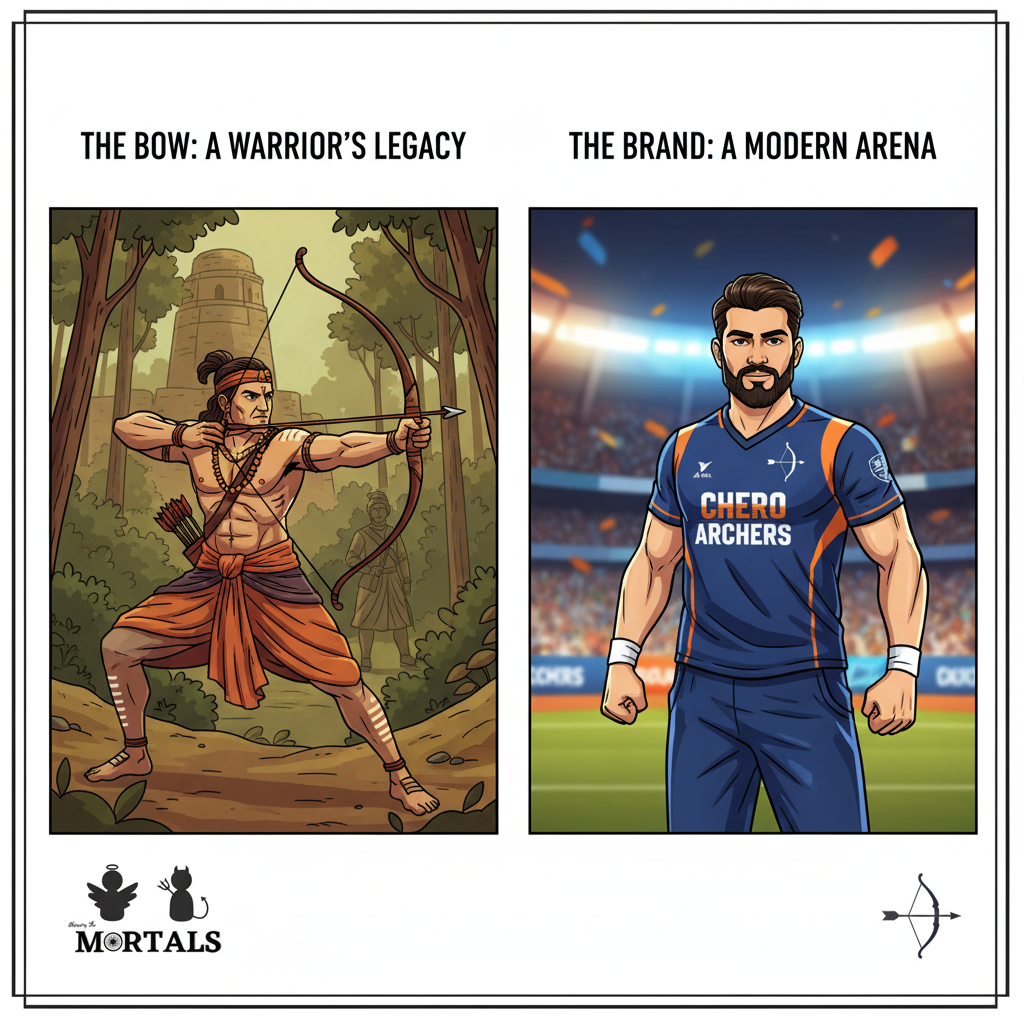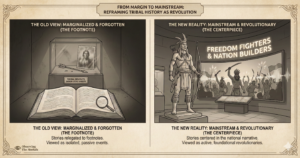When a new sports franchise is named, it seeks a title that evokes power, skill, and regional pride. For the new Jharkhand team in the upcoming Archery Premier League, the name chosen was the “Chero Archers.” But this is far more than just a catchy brand. Behind this modern franchise lies the deep, often-forgotten history of a legendary tribal warrior clan that once ruled from the forests of Palamu. They were, as historians note, the “Davids of their time,” standing against the Goliaths of the Mughal and British empires. This case study explores the fascinating journey of a historical tribal identity as it is revived and repurposed for the 21st-century sporting arena.
The Information Box
Syllabus Connection:
- Paper 2: Chapter 1.1 (Contribution of Tribal Culture to Indian Civilization), Chapter 9.3 (Tribal Movements & Resistance)
- Paper 1: Chapter 4 (Political Anthropology), Chapter 9 (Applied Anthropology: Commodification of Culture)
Key Concepts/Tags:
- Chero Tribe, Tribal History, Resistance Movements, Symbolic Appropriation, Sports Anthropology, Jharkhand
The Setting: Who, What, Where?
The contemporary setting is the launch of the new Archery Premier League (APL) and the naming of its Jharkhand-based franchise. This modern event, however, is deeply rooted in the historical setting of the Palamu region of Jharkhand. The name pays tribute to the Chero tribe, a once-powerful ruling clan renowned for their fierce independence and mastery of archery. The article highlights their long history of resistance, from famous rulers like Medini Rai who fought the Mughals, to the 19th-century heroes, brothers Nilamber and Pitamber, who led a major revolt against the British in 1857.
The Core Argument: Why This Study Matters
This is not just a story about a sports team; it’s a powerful case study in the modern life of a historical identity.

- Reclaiming a Forgotten History: The naming of the team serves as a powerful act of public history. It brings the story of the Chero—a formidable tribal kingdom that fiercely resisted imperial expansion for centuries—out of academic books and into the mainstream consciousness. It highlights a narrative of Adivasi history that is not one of passive victimhood, but of active, prolonged political and military resistance.
- The “David vs. Goliath” Narrative: The article repeatedly frames the Chero as the “Davids of their time.” This narrative of the brave underdog, using their traditional skills (archery) and knowledge of the terrain to fight a technologically superior force (Mughal and British cannons and firearms), is a powerful and romantic story. This heroic image is perfectly suited for building the identity and fan base of a modern sports team.
- The Commodification of Tribal Identity: This is the key anthropological process at play. A complex historical identity, forged through centuries of state-formation, war, and eventual decline, is being transformed into a brand. The name “Chero Archers” and their story are being used as symbolic capital to create a marketable identity for a commercial sports franchise, one that evokes bravery, skill, and deep regional pride.
The Anthropologist’s Gaze: A Critical Perspective
- Symbolic Appropriation vs. Genuine Empowerment: An anthropologist would ask a critical question: Who truly benefits from this revival of the Chero name? Does it lead to tangible benefits for the contemporary Chero community in terms of resources, improved social standing, or a greater political voice? Or is it merely symbolic appropriation, where their historical name and “warrior” image are used for commercial gain by franchise owners who may have little connection to the community’s present-day struggles and realities?
- The “Folklorization” of History: This process can be seen as a form of “folklorization,” where a complex and often tragic history is simplified and romanticized. The focus is on the heroic “warrior” aspect, which is marketable. This can inadvertently erase the more nuanced parts of their history—the political complexities of their rule, their eventual defeat, and the long, difficult story of their subsequent marginalization. A brand requires a simple, heroic story; history is rarely so simple.
- The Cultural Significance of Archery: An anthropologist would also focus on the sport itself. Archery is not just a sport in Jharkhand; it is a deep cultural tradition for many Adivasi communities (like the Santals and Mundas as well). The APL is tapping into this existing cultural reservoir. The critical question is whether the league will genuinely nurture this grassroots talent and celebrate its cultural roots, or simply use the historical imagery for superficial branding.
The Exam Angle: How to Use This in Your Mains Answer
- Types of Questions Where It can be Used:
- “Discuss the contribution of tribal cultures and kingdoms to Indian history.”
- “Analyze the nature of tribal resistance movements during the colonial period.”
- “Discuss the impact of modernity and globalization on tribal identity.”
- Model Integration:
- On Tribal History (Paper 2): “The contribution of tribal communities to Indian history includes a rich legacy of state formation and resistance. The Chero kingdom of Palamu, for example, fiercely resisted both Mughal and British expansion for centuries, a history of Adivasi sovereignty that is now being symbolically revived in the name of the ‘Chero Archers’ sports team.”
- On Tribal Identity & Modernity: “In the contemporary era, historical tribal identities are often repurposed in new, globalized contexts. The naming of a professional archery team after the ‘Chero Archers’ of Jharkhand is a prime example of the commodification of a historical warrior identity for the purposes of modern commercial branding and the creation of regional pride.”
- To offer a critique (Applied Anthro): “The use of tribal names and symbols in modern branding, such as the ‘Chero Archers’ franchise, raises critical anthropological questions of symbolic appropriation versus genuine empowerment. An analysis must probe whether such an initiative provides tangible benefits to the contemporary Chero community or merely commercializes their historical legacy for an external audience.”
Observer’s Take
The story of the Chero Archers is a fascinating example of how the ghosts of history are resurrected in the modern marketplace. On one hand, it is a powerful and positive step to see a forgotten Adivasi legacy of resistance and skill brought into the mainstream narrative. On the other, it walks a fine line between tribute and commercialization. The true homage to the legacy of Medini Rai, Nilamber, and Pitamber will be paid not just by winning medals, but by ensuring that the contemporary Chero community, and Adivasi archers across the region, are seen, heard, and empowered to become the true inheritors and beneficiaries of their legendary name.





